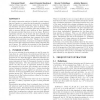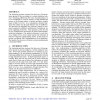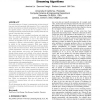DMKD
2003
ACM
14 years 4 months ago
2003
ACM
An inference problem exists in a multilevel database if knowledge of some objects in the database allows information with a higher security level to be inferred. Many such inferen...
DMKD
2003
ACM
14 years 4 months ago
2003
ACM
We analyze expression matrices to identify a priori interesting sets of genes, e.g., genes that are frequently co-regulated. Such matrices provide expression values for given biol...
DMKD
2003
ACM
14 years 4 months ago
2003
ACM
DMKD
2003
ACM
14 years 4 months ago
2003
ACM
HTML anchors are often surrounded by text that seems to describe the destination page appropriately. The text surrounding a link or the link-context is used for a variety of tasks...
DMKD
2003
ACM
14 years 4 months ago
2003
ACM
The parallel explosions of interest in streaming data, and data mining of time series have had surprisingly little intersection. This is in spite of the fact that time series data...
DMKD
2003
ACM
14 years 4 months ago
2003
ACM
Homeland security measures are increasing the amount of data collected, processed and mined. At the same time, owners of the data raised legitimate concern about their privacy and...
DMKD
2003
ACM
14 years 4 months ago
2003
ACM
DMKD
2003
ACM
14 years 4 months ago
2003
ACM
Given a known protein sequence, predicting its secondary structure can help understand its three-dimensional (tertiary) structure, i.e., the folding. In this paper, we present an ...




